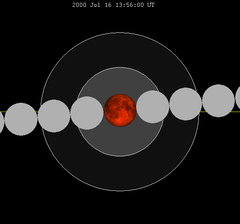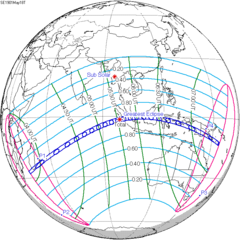| Total eclipse | |||||||||||||||||
 The Moon's hourly motion shown right to left The Moon's hourly motion shown right to left | |||||||||||||||||
| Date | May 24, 1910 | ||||||||||||||||
|---|---|---|---|---|---|---|---|---|---|---|---|---|---|---|---|---|---|
| Gamma | −0.3976 | ||||||||||||||||
| Magnitude | 1.0950 | ||||||||||||||||
| Saros cycle | 129 (32 of 71) | ||||||||||||||||
| Totality | 49 minutes, 30 seconds | ||||||||||||||||
| Partiality | 215 minutes, 21 seconds | ||||||||||||||||
| Penumbral | 360 minutes, 20 seconds | ||||||||||||||||
| |||||||||||||||||
| ← November 1909November 1910 → | |||||||||||||||||
A total lunar eclipse occurred at the Moon’s descending node of orbit on Tuesday, May 24, 1910, with an umbral magnitude of 1.0950. A lunar eclipse occurs when the Moon moves into the Earth's shadow, causing the Moon to be darkened. A total lunar eclipse occurs when the Moon's near side entirely passes into the Earth's umbral shadow. Unlike a solar eclipse, which can only be viewed from a relatively small area of the world, a lunar eclipse may be viewed from anywhere on the night side of Earth. A total lunar eclipse can last up to nearly two hours, while a total solar eclipse lasts only a few minutes at any given place, because the Moon's shadow is smaller. Occurring about 2.4 days after apogee (on May 21, 1910, at 18:30 UTC), the Moon's apparent diameter was smaller.
This lunar eclipse was the third of a tetrad, with four total lunar eclipses in series, the others being on June 4, 1909; November 27, 1909; and November 17, 1910.
Visibility
The eclipse was completely visible over much of North America, South America, and Antarctica, seen rising over northwestern North America, eastern Australia, and the central Pacific Ocean and setting over Africa and Europe.
 
|
Eclipse details
Shown below is a table displaying details about this particular solar eclipse. It describes various parameters pertaining to this eclipse.
| Parameter | Value |
|---|---|
| Penumbral Magnitude | 2.16249 |
| Umbral Magnitude | 1.09503 |
| Gamma | −0.39758 |
| Sun Right Ascension | 04h00m18.2s |
| Sun Declination | +20°36'19.8" |
| Sun Semi-Diameter | 15'47.5" |
| Sun Equatorial Horizontal Parallax | 08.7" |
| Moon Right Ascension | 15h59m50.9s |
| Moon Declination | -20°56'56.9" |
| Moon Semi-Diameter | 14'47.6" |
| Moon Equatorial Horizontal Parallax | 0°54'17.6" |
| ΔT | 10.9 s |
Eclipse season
See also: Eclipse cycleThis eclipse is part of an eclipse season, a period, roughly every six months, when eclipses occur. Only two (or occasionally three) eclipse seasons occur each year, and each season lasts about 35 days and repeats just short of six months (173 days) later; thus two full eclipse seasons always occur each year. Either two or three eclipses happen each eclipse season. In the sequence below, each eclipse is separated by a fortnight. The first and last eclipse in this sequence is separated by one synodic month.
| May 9 Ascending node (new moon) |
May 24 Descending node (full moon) |
|---|---|
 |

|
| Total solar eclipse Solar Saros 117 |
Total lunar eclipse Lunar Saros 129 |
Related eclipses
Eclipses in 1910
- A total solar eclipse on May 9.
- A total lunar eclipse on May 24.
- A partial solar eclipse on November 2.
- A total lunar eclipse on November 17.
Metonic
- Preceded by: Lunar eclipse of August 4, 1906
- Followed by: Lunar eclipse of March 12, 1914
Tzolkinex
- Preceded by: Lunar eclipse of April 12, 1903
- Followed by: Lunar eclipse of July 4, 1917
Half-Saros
- Preceded by: Solar eclipse of May 18, 1901
- Followed by: Solar eclipse of May 29, 1919
Tritos
- Preceded by: Lunar eclipse of June 23, 1899
- Followed by: Lunar eclipse of April 22, 1921
Lunar Saros 129
- Preceded by: Lunar eclipse of May 11, 1892
- Followed by: Lunar eclipse of June 3, 1928
Inex
- Preceded by: Lunar eclipse of June 12, 1881
- Followed by: Lunar eclipse of May 3, 1939
Triad
- Preceded by: Lunar eclipse of July 23, 1823
- Followed by: Lunar eclipse of March 24, 1997
Lunar eclipses of 1908–1911
| This section is empty. You can help by adding to it. (December 2024) |
Saros 129
Lunar saros series 129, repeating every 18 years and 11 days, containing 71 events, has 11 total lunar eclipses. The first total lunar eclipse of this series was on May 24, 1910, and last will be on September 8, 2090. The longest occurrence of this series was on July 16, 2000 when totality lasted 106 minutes and 24.6 seconds.
| Greatest | First | |||
|---|---|---|---|---|
 The greatest eclipse of the series occurred on 2000 Jul 16, lasting 106 minutes. |
Penumbral | Partial | Total | Central |
| 1351 Jun 10 | 1513 Sep 15 | 1910 May 24 | 1946 Jun 14 | |
| Last | ||||
| Central | Total | Partial | Penumbral | |
| 2036 Aug 7 | 2090 Sep 8 | 2469 Apr 26 | 2613 Jul 24 | |
| 1910 May 24 | 1928 Jun 3 | 1946 Jun 14 | |||

|

|

|

|

|

|
| 1964 Jun 25 | 1982 Jul 6 | 2000 Jul 16 | |||

|

|

|

|

|

|
| 2018 Jul 27 | 2036 Aug 7 | 2054 Aug 18 | |||

|

|

|

|

|

|
| 2072 Aug 28 | 2090 Sep 8 | ||||

|

|

|

| ||
It last occurred on May 11, 1892 and will next occur on June 3, 1928.
This is the 32nd member of Lunar Saros 129, and the first total eclipse. The next event is the June 1928 lunar eclipse. Lunar Saros 129 contains 11 total lunar eclipses between 1910 and 2090. Solar Saros 136 interleaves with this lunar saros with an event occurring every 9 years 5 days alternating between each saros series.
Inex series
The inex series repeats eclipses 20 days short of 29 years, repeating on average every 10571.95 days. This period is equal to 358 lunations (synodic months) and 388.5 draconic months. Saros series increment by one on successive Inex events and repeat at alternate ascending and descending lunar nodes.
This period is 383.6734 anomalistic months (the period of the Moon's elliptical orbital precession). Despite the average 0.05 time-of-day shift between subsequent events, the variation of the Moon in its elliptical orbit at each event causes the actual eclipse time to vary significantly. It is a part of Lunar Inex series 35.
| Descending node | Ascending node | Descending node | Ascending node | ||||
|---|---|---|---|---|---|---|---|
| Saros | Date Chart |
Saros | Date Chart |
Saros | Date Chart |
Saros | Date Chart |
| 115 | 1505 Feb 18
|
116 | 1534 Jan 30
|
117 | 1563 Jan 9 | 118 | 1591 Dec 30 |
| 119 | 1620 Dec 9 | 120 | 1649 Nov 19 | 121 | 1678 Oct 29 | 122 | 1707 Oct 11 |
| 123 | 1736 Sep 20 | 124 | 1765 Aug 30 | 125 | 1794 Aug 11 | 126 | 1823 Jul 23 |
| 127 | 1852 Jul 1 | 128 | 1881 Jun 12 | 129 | 1910 May 24
|
130 | 1939 May 3
|
| 131 | 1968 Apr 13
|
132 | 1997 Mar 24
|
133 | 2026 Mar 3
|
134 | 2055 Feb 11
|
| 135 | 2084 Jan 22
|
136 | 2113 Jan 2 | 137 | 2141 Dec 13 | 138 | 2170 Nov 23 |
| 139 | 2199 Nov 2 | 140 | 2228 Oct 14 | 141 | 2257 Sep 24 | 142 | 2286 Sep 3 |
| 143 | 2315 Aug 16 | 144 | 2344 Jul 26 | 145 | 2373 Jul 5 | 146 | 2402 Jun 16 |
| 147 | 2431 May 27 | 148 | 2460 May 5
|
149 | 2489 Apr 16
| ||
Half-Saros cycle
A lunar eclipse will be preceded and followed by solar eclipses by 9 years and 5.5 days (a half saros). This lunar eclipse is related to two total solar eclipses of Solar Saros 136.
| May 18, 1901 | May 29, 1919 |
|---|---|

|

|
See also
Notes
- "May 23–24, 1910 Total Lunar Eclipse (Blood Moon)". timeanddate. Retrieved 16 December 2024.
- "Moon Distances for London, United Kingdom, England". timeanddate. Retrieved 16 December 2024.
- "Total Lunar Eclipse of 1910 May 10" (PDF). NASA. Retrieved 16 December 2024.
- "Total Lunar Eclipse of 1910 May 24". EclipseWise.com. Retrieved 16 December 2024.
- Mathematical Astronomy Morsels, Jean Meeus, p.110, Chapter 18, The half-saros
External links
- 1910 May 24 chart Eclipse Predictions by Fred Espenak, NASA/GSFC
This lunar eclipse-related article is a stub. You can help Misplaced Pages by expanding it. |


